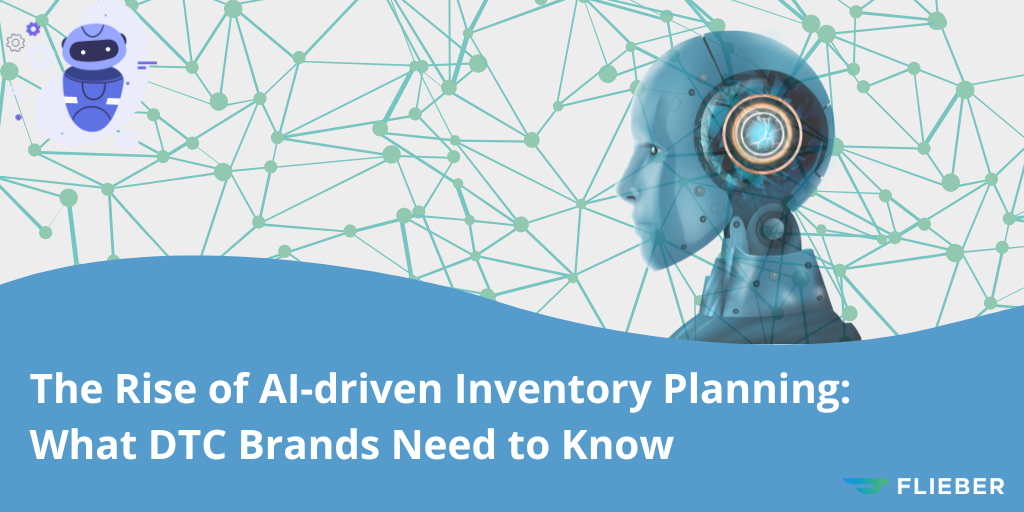With the rise of generative AI like ChatGPT, Bard and Adobe Firefly, there is great potential for DTC brands to increase their productivity using the power of machine learning.
There is also a lot of hype.
Between Amazon’s billion-dollar AI investment and robots writing pizza recipes made entirely of sound waves, navigating the AI echochamber to come away with real use cases for your business is a very real problem for e-commerce leaders.
Like any field with vast amounts of data and myriad execution options, inventory is one area where AI will be instrumental in changing the way brands operate.
But how exactly can it help?
Table of contents
- How AI is ushering in a new era of inventory planning
- AI + inventory visibility = stronger operations
- Clean data is a must for accurate AI forecasting
- AI can help you find success with inventory as you scale
How AI is ushering in a new era of inventory planning
It’s no secret that inventory is the biggest and most complex challenge in the world of e-commerce. Unlike marketing and advertising, it’s also the least “sexy” part of the business.
Despite its role as the backbone of a retail business, inventory’s impact is all about driving efficiencies behind the scenes.
As retailers transition from a focus on top line growth, to a more sustainable focus of achieving healthy bottom-line profits, AI can help prove the value of a well-planned inventory operation.
In the new era of retail, AI gives you the tools and insights you need to go beyond clunky processes like adding macros to Excel sheets, to making profitable data-driven decisions in real-time.
Here are some of the ways AI is already making that happen.
1. AI + inventory visibility = stronger operations
Despite the buzz, the key to mastering your inventory isn't machine learning. The real solution is far simpler:
It’s the ability to see what’s happening with your inventory in real-time.
With multiple sales channels and inventory locations, visibility is key to understanding how your inventory behaves. And the more selling opportunities there are, the greater the need.
In the omnichannel era, there is an endless number of inventory and supply chain variables to plan for, and that’s exactly what makes AI so appealing.
When combined with a centralized view of your inventory across multiple sales channels and inventory locations, AI can help elevate your visibility by generating insights from past trends, current inventory levels, and en route orders at a speed that is much faster than legacy systems or manual Excel-based forecasting.
With deep visibility into the entire inventory and fulfillment process, you can use AI for:
- Stronger forecasts
- Reduced risk of stockouts
- Transparent communications across teams
- Optimized inventory across multiple warehouse locations
For example, if you sell on Amazon and Shopify, you already have a more complex inventory network due to the use of a third-party logistics (3PL) provider for product storage and fulfillment to Shopify.
This 3PL provider also sends products to Amazon's fulfillment network (FBA), resulting in inventory in two different locations — one location serves both Shopify and Amazon, while the other location serves only Amazon. This may be doable for a time, but the more channels you add, the messier things get.
Inventory is an area with vast amounts of data and many possible execution options. While AI can improve forecasts and assist in the decision making process, it isn’t a substitute for inventory planners — inventory data is simply too fragmented.
Combining real-time data in a single location and standardized format will remain a challenge in the years to come, but adding AI to your inventory planning can still be a gamechanger.
You need to know how selling accounts are connected to inventory locations, and which ones function as storage or fulfillment. This becomes even more critical when dealing with additional complexities like subscriptions, bundles, kits, pre-orders, or backorders.
From simple tasks like understanding your current inventory status to more sophisticated use cases, such as defining the best replenishment decision in a complex inventory scenario, AI technology will offer new superpowers to inventory planners.
For DTC brands selling across multiple channels, a clear view of your inventory mapping combined with powerful AI gives you everything you need to get the right products to the right place at the right time, for a better customer experience.
2. Clean data is a must for accurate AI forecasting
Garbage in, garbage out.
The old adage is particularly true when using AI in your demand forecasting. In a fast-paced industry like e-commerce, it’s common for raw data to be incomplete or riddled with errors and anomalies.
Even one small error can have a huge impact on your forecasting.
For instance, let’s say you want to use AI to generate recommendations for a purchase order. If your forecast is based on sales data that includes past stockouts, it’s easy for AI to view that as a seasonal pattern, rather than an outlier. The AI will fail to order enough replenishments, leading to more stockouts in the future.
To prevent this from happening, make sure your forecasts are based on accurate data, including your historical sales trends, seasonality, past stockouts, price changes, and more.
Take action on the following factors in your inventory data:
- Lost sales substitution - Identify the times your store experienced a loss of sales due to a low-in-stock product or stockout, then add the sales you should have had to prevent the AI from misinterpreting this as seasonality.
- Price normalization - Pinpoint days that had a sales spike due to a price promotion or advertising campaign, then “normalize” those events in your data to avoid overstocks.
- Outlier normalization - Common outliers could be caused by sales spikes due to influencer campaigns or a sudden Amazon listing suspension.
An outlier is an event that occurred only once in your store and wasn’t motivated by low stock, or changes in pricing or ad spend, and they are incredibly common in e-commerce. As smart as AI is, it doesn’t have the ability to contextualize these outliers in your inventory data.
That’s where data preprocessing can help. Data preprocessing is the process of taking raw data and converting it to clean, usable sets that, with the help of AI-driven forecasting, can lead to better replenishment decisions and a decrease in costly stockouts.
By teaching the AI to recognize outliers in your sales and inventory data, you can train it to deliver stronger and more accurate forecasts, even as you increase the number of sales and inventory locations in your business.
For example, let’s say you’re a houseware brand with multiple sales channels pulling inventory from the same warehouse. You decide to run a flash sale on a random day (not a holiday) for app-users only, to encourage more app sales.
AI can create a forecast that ensures enough inventory to cover a sudden uptick in sales, while recognizing that this flash sale is an anomaly when planning inventory for the next month, or for the same month next year.
3. AI can help you find success with inventory as you scale
In the world of post-pandemic e-commerce, success means being able to make confident decisions in real-time.
Yet despite the hype, AI will not be able to take over the entire inventory decision making process any time soon. However, it can help faster, data-driven decisions as you scale.
Here are some of the ways AI can help you make better inventory decisions:
- Identify inventory consumption patterns and suggest corrections
- Dive deeper into your sales history and forecast for specific products
- Clarify the variability in your sales data
- Offer data-driven suggestions for real-time sales and inventory adjustments
These insights can help you make decisions that reduce the likelihood of filling warehouse space with slow-moving inventory, or not being able to give the customer what they want due to out-of-stock items, empowering you to plan your replenishment with greater confidence.
A better way to plan your inventory
When it comes to emerging technologies like AI, those of us with an active role in inventory planning have been largely overlooked.
With a rocky supply chain and constant changes in demand, you’ve likely had to create your own internal processes for planning your inventory just to keep your operations running.
While that may have worked well enough in the past, the rise of AI in inventory planning means that the systems and processes that got you where you are today, won’t be the same ones that take you where you want to go tomorrow.
AI makes complex inventory planning simpler, easier to monitor, and more accurate, so you can make better decisions in a fraction of the time. As it becomes less of a trending topic and more of a retail business best practice, more brands will use AI to make profitable inventory decisions.
Will you be one of them? Learn more about how you can use AI to unlock a whole new level of efficiency and effectiveness in inventory planning. Schedule a demo today to see how Flieber can help you elevate your inventory and let’s keep Fliebing!



-1.png)

